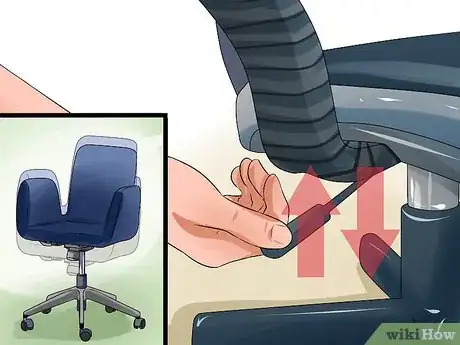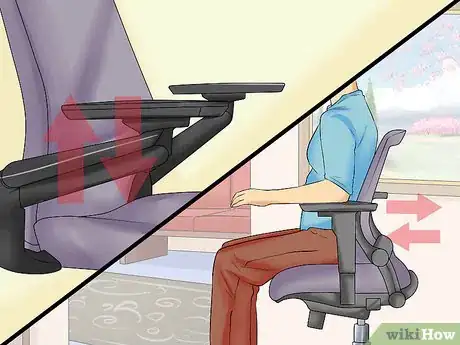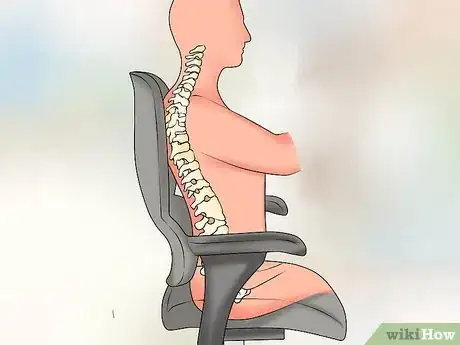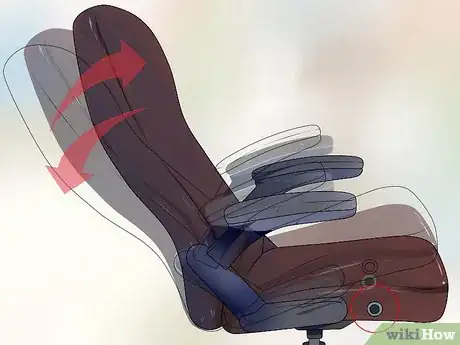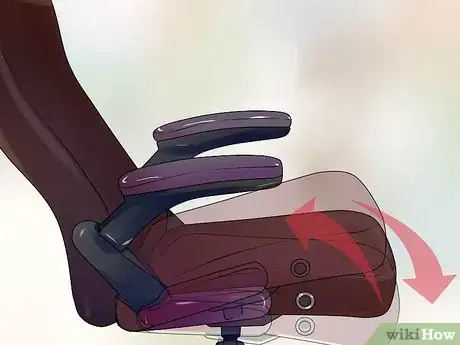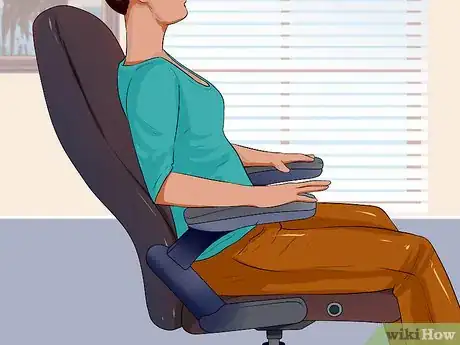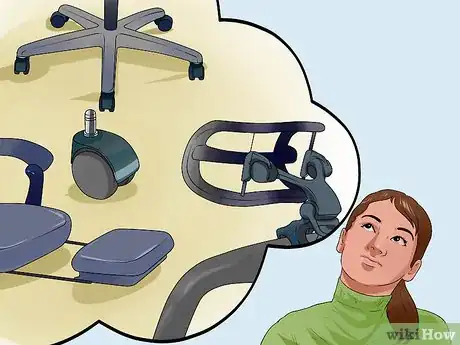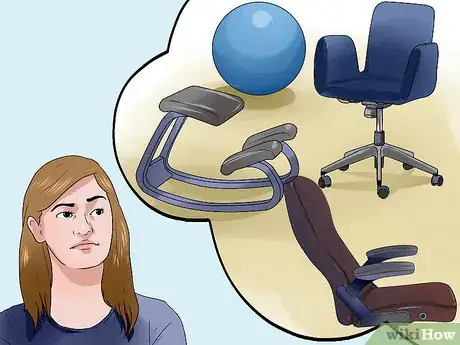This article was medically reviewed by Troy A. Miles, MD. Dr. Miles is an Orthopedic Surgeon specializing in Adult Joint Reconstruction in California. He received his MD from the Albert Einstein College of Medicine in 2010, followed by a residency at the Oregon Health & Science University and fellowship at the University of California, Davis. He is a Diplomat of the American Board of Orthopaedic Surgery and is a member of the American Association of Hip and Knee Surgeons, American Orthopaedic Association, American Association of Orthopaedic Surgery, and the North Pacific Orthopaedic Society.
This article has been viewed 99,162 times.
It may not seem like a big deal, but selecting the right ergonomic chair for your desk or office can make a difference in your health and comfort. Sitting for extended periods of time can put a large amount of stress on the back and spine, which can result in back problems and serious discomfort. Learning more about how to select the proper ergonomic office chair can help you avoid these health issues, improve your posture and stay comfortable throughout your work day.
Steps
Evaluating the Chair's Adjustment Capabilities
-
1Look for the ability to adjust the chair's height. The height of your ergonomic chair should be fully adjustable. The chair's seat should be easy to move either upwards or downwards. This adjustment will allow for people of different heights to comfortably sit in the chair. Make sure you can adjust how high or low the the seat is before purchasing your chair.[1] [2]
- A seat height of 15” to 22” will comfortably seat a person between 5'0" to 6'4" tall.
- Most chairs will offer only a small range of adjustment.
- Your feet should be able to sit flat on the floor while your knees are bent at ninety degree angles.
-
2Consider who will be using the chair. Before you select an ergonomic chair, you'll want to think of who will be using the chair. The chair will need to comfortably fit anyone who will sit in it or be able to be adjusted to fit them. Make sure your chair is a good fit for anyone in your office before making a purchase.[3]
- The chair you are interested in should comfortably fit the person it is intended for.
- Many ergonomic chairs will be adjustable enough to accommodate most anyone.
Advertisement -
3Make sure elements of the chair can be individually adjusted. A good ergonomic chair will allow you to adjust each part of the chair by itself. You should be able to move the armrests, seat and back supports independently of each other. This level of customization will allow you to make the chair a good fit for anyone that might end up using it.[4]
- You may want to avoid chairs that don't allow for adjustments.
- Generally, you will want to select chairs that have a large number of adjustable features.
Evaluating the Chair's Back Support
-
1Check the chair for adequate upper and middle back support. Proper ergonomic chairs will offer full upper and middle back support. If you are going to be sitting for a long period of time, supporting your back and its natural shape will be important in preventing injury or strain. Make sure your ergonomic chair has excellent upper and middle back support before making a purchase.[5]
- The backrest should be between 12” and 19” wide.
- Your chair's backrest should support the natural curve and shape of your back.
- Most backrests will be adjustable to support the contours of your back.
-
2Examine the chair's lumbar support. Chairs without proper lumbar support will have a damaging and flattening effect on your lower back. The lower back has a natural inward curve and poorly designed chairs will cause this curve to straighten out. Make sure your chair helps you maintain your lower back's normal curvature to help your back stay strong and healthy.[6]
- Lumbar support can be adjusted by raising or lowering the chair's back support pad.
- Chairs that have an unadjustable back won't be a good fit for everyone.
-
3Make sure the backrest can be adjusted or reclined. Being able to recline or adjust the back of your chair will affect the amount of weight placed on your lower back. If you are planning on being seated for a majority of the day, reclining can help relieve pressure on your spinal discs and lower back muscles.[7]
- Avoid buying an ergonomic chair that can't recline.
- Most chairs can be locked into the most comfortable reclined position you find.
- Back pressure is lowest between 110° and 130° of reclining.
- People with lower back injuries can benefit the most from reclining chairs.
Evaluating the Chair's Seat
-
1Make sure the seat is the right size for you. Seats that are too big or too small can affect your comfort and health when using them for long periods of time. When you are searching for a good ergonomic chair, you'll want to make sure that the seat is right size for you or anyone using it. Keep some of these criteria in mind when judging the seat size of an ergonomic chair:[8]
- The seat should be about an inch wider than your hips.
- The seat pan should be positioned just behind your knees.
-
2Check the padding of the seat. You will likely be spending a large amount of time seated in your ergonomic chair. Because of this, you'll want to make sure that your chair is properly and adequately padded to help ensure comfort and ergonomic support. Make sure the chair's seat is made of high quality foam before making a purchase.[9]
- Low quality foam can break down quickly, causing your chair to become uncomfortable.
- You should be able sit comfortably in the chair for at least an hour.
- Improperly padded chair seats can cause misalignments in the hips and back issues.
-
3Consider if you can tilt the seat of the chair. Although the ability to tilt the chair's seat is often optional, you may still want to have this feature included in your chair. Tilting the chair seat can help you maintain proper posture when sitting in the chair. If you think the ability to tilt your chair's seat would help you sit more comfortably, check to see if your ergonomic chair has this capability.[10] [11]
Finalizing Your Choice
-
1Try out chairs in person. Although you can learn a lot about a chair from reading its specifications, it's still a good idea to try a chair out in person. By sitting in a chair, you will be able to directly feel how comfortable it is and learn if it can be properly adjusted to your needs. Whenever possible, try to examine an ergonomic chair in person to make sure it's the one for you.
-
2Consider the details of the chair. There are many features to consider when looking for the perfect ergonomic chair. Because there is so much to consider, some aspects of the chair may get overlooked. Think about some of the following parts of the chair you are looking at to help you finalize your choice:[12]
- Chair bases should have five spokes.
- The chair's casters should move easily and freely.
- If the chair comes with a headrest, make sure it's a good fit for your body type.
- You may need a foot rest if the chair's height is too high and cannot be adjusted.
- You'll want to think about which chair covering is best. Vinyl coverings can be easy to clean but don't breathe well. Cloth seat covers can allow for airflow but may be tougher to keep clean.
-
3Think about different chair styles. There are many different types and styles of ergonomic chairs available. These chairs will differ from the traditional style of chair and each will have its own unique benefit and purpose. Take a look at some of these unique styles of ergonomic chairs to learn if one of them might be a good fit for your needs.[13]
- Kneeling chairs have no back and can help you to improve your posture and back health.
- Saddle chairs are good choices for computer or desk work. They are shaped like a horse saddle and can help make your back stronger and healthier.
- Exercise balls can help keep you moving and actively require you to stay balanced.
- For people with back issues, reclining chairs with footrests can be the most comfortable choice.
References
- ↑ http://www.thehumansolution.com/how-to-choose-the-best-ergonomic-chair.html
- ↑ http://www.spine-health.com/wellness/ergonomics/office-chair-choosing-right-ergonomic-office-chair
- ↑ http://ergo.human.cornell.edu/ahtutorials/chairch.html
- ↑ http://www.thehumansolution.com/how-to-choose-the-best-ergonomic-chair.html
- ↑ http://www.spine-health.com/wellness/ergonomics/office-chair-choosing-right-ergonomic-office-chair
- ↑ http://www.thehumansolution.com/how-to-choose-the-best-ergonomic-chair.html
- ↑ http://www.thehumansolution.com/how-to-choose-the-best-ergonomic-chair.html
- ↑ http://www.thehumansolution.com/how-to-choose-the-best-ergonomic-chair.html
- ↑ http://ergo.human.cornell.edu/ahtutorials/chairch.html
- ↑ http://www.thehumansolution.com/how-to-choose-the-best-ergonomic-chair.html
- ↑ http://ergo.human.cornell.edu/ahtutorials/chairch.html
- ↑ http://ergo.human.cornell.edu/ahtutorials/chairch.html
- ↑ http://www.spine-health.com/wellness/ergonomics/office-chair-ergonomic-chair-alternatives-traditional-office-chairs
